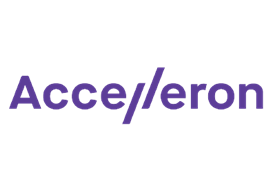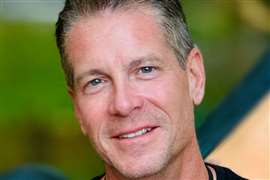High Tide At SMM Show
09 September 2024
Flush of product launches at SMM maritime show in Hamburg
The 2024 edition of the SMM maritime show in Hamburg, Germany, promised to be very exciting already in the weeks before the event’s start, with a flurry of invitations to press events, product unveilings, and opportunities for interviews with key players.
As things unfortunately played out, I had to miss the show altogether due to a little last-minute problem. I have it from good authority though (colleagues and industry contacts) that SMM kept its promises, with a lively edition and a general enthusiasm among participants as sometimes happens when professional crowds gather at major specialized shows.
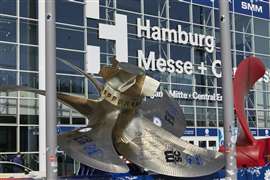 SMM maritime show took place in Hamburg, Germany, from 3 to 6 September 2024.
SMM maritime show took place in Hamburg, Germany, from 3 to 6 September 2024.
Curiously, while the general mood in the halls of SMM was upbeat, reports were being published on German industrial production falling more than expected in July 2024. Reuters published on September 6th the news that German production fell by 2.4% compared with the previous month - analysts polled by Reuters had predicted a 0.3% fall.
The contraction is mainly driven by a weak performance from the automotive sector, and spurred fears that Europe’s largest economy could contract again in the third quarter. That would be the second consecutive quarter of contraction, sparking fears of another recession, marked by two consecutive quarters of contraction.
Yet, the mood around the maritime community was excellent, as stated also by the show’s organizers, Hamburg Messe + Congress, in their preliminary report: a fully booked hall plan with more than 2,200 exhibiting companies and over 48,000 participants from more than 100 countries.
Decarbonization challenges
The event was a showcase for the latest trend and technologies in the maritime industry, with an eye to making ship fleets more efficient and greener - “a direction that demands the industry to take courageous investment decisions,” according to Martin Kröger, managing director of the German Shipowners Association (VDR).
As customary, the leading classification society and advisor for the marine shipping industry, DNV Maritime, released its updated Maritime Forecast to 2025 just days before the show in Hamburg.
It is an interesting and detailed analysis of the IMO Decarbonization goals towards full decarbonization in 2025 and the paths and solutions available to reach them. (The full report is available for download on the DNV website.)
A couple of remarks struck me in the foreword to the report by DNV Maritime’s CEO, Knut Ørbeck-Nilssen: “While the industry is continuing to embrace diverse fuel technologies like LNG, LPG, methanol, and ammonia, and the production of green fuels is also underway but with large-scale supply remaining elusive, today’s reality is that 93% of the world fleet is still running on conventional fossil fuels.”
He added that: “Decarbonizing shipping will come at a cost. Maritime Forecast to 2050 estimates that to achieve the IMO’s final and intermediate reduction ambitions in well-to-wake emissions, costs per tonne-mile could increase significantly compared to business as usual. Increased freight rates will have to be passed through the value chain, with consumers likely to pick up most of the tab.”
Given these premises, it did not come as much of a surprise that several product launches at SMM focused on internal combustion engines, operation with new fuels, and hybrid solutions.
What follows here is a brief (and by no means exhaustive) recap of products and solutions announced at the show. They are merely what reached our editorial team from the players in the fields of propulsion and auxiliary technologies, which are the main focus of our publications.
 Interest around the new Evolve 8EL23 marine engine, launched by ABC.
Interest around the new Evolve 8EL23 marine engine, launched by ABC.
PRIME MOVERS:
ABC. Anglo-Belgian Corporation is busy with the rapid expansion of its fuel-flexible Evolve engine platform, and at SMM presented the new medium-speed eight-cylinder inline Evolve 8EL23.
This engine follows the launches of the four-cylinder and six-cylinder units 4EL23 and 6EL23, completing the Evolve inline engine lineup with fuel-flexible solutions.
In fact, the versatile cylinder head design of the Evolve engines allows for straightforward conversion between liquid, dual, and gaseous fuels, and is pre-designed to support multiple fuel options and various firing solutions.
The new Evolve 8EL23 has a nominal power range between 1,640 and 2,880 kW at engine speed from 400 and 1,200 rpm.
BAUDOUIN. Moteurs Baudouin, a brand of Weichai, showcased its M33.3 range of marine engines that includes six- and 16-cylinder models.
The company launched its new eight-cylinder common rail engine type 8F21.
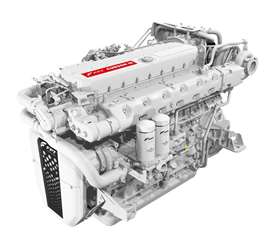 For onboard auxiliaries: FPT Industrial launched its new C16 G-Drive engine
For onboard auxiliaries: FPT Industrial launched its new C16 G-Drive engine
FPT INDUSTRIAL focused on auxiliary engines, exhibiting its fixed-speed G-drive engine lineup (from 4.5 to 16 L displacement) including the Stage 5 N67 G-Drive and the C90 G Drive.
The company launched the new C16 G-Drive engine certified for IMO Tier 2, EPA Tier 3, and China GB2 emissions regulations. This unit is a new development based on the C16 600 propulsion engine and delivers 16 L performance in a 13 L package.
The new engine is suitable for onboard generators of 390 kVA, 50 Hz and 470 kVA, 60 Hz or for fixed-speed diesel-electric applications. This unit can be operated for continuous use, with prime power ratings of 331 kWm at 1,500 rpm and 397 kWm at 1,800 rpm, with a 10% overload capability according to ISO 8528.
The C16 G Drive offers a series of options, among which are a new block heater for uses below -10° C (14° F), the speed controller, the RINA kit and the front PTO. Heat exchanger and keel cooling versions are available and maintenance intervals are at 600 hours.
MAN Engines launched the new D3872 V12 workboat engine, displaying at the show the model for medium-duty applications with an output power of 1,213 kW (1,650 hp) at 2,100 rpm.
Further power variants of this engine type (1,471 and 1,618 kW, or 2,000 and 2,200 hp, at 2,300 rpm) for light-duty applications are already in production.
You can find more details on the 30-liter MAN D3872 in a dedicated article on this website.
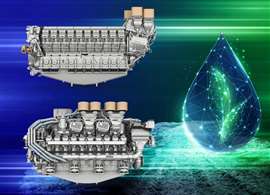 At Rolls-Royce: large mtu marine engines are approved for HVO fuel and meet IMO Tier 3 with SCR.
At Rolls-Royce: large mtu marine engines are approved for HVO fuel and meet IMO Tier 3 with SCR.
Rolls-Royce announced that its mtu large engines Series 1163 and 8000 are now approved for HVO fuel and other DIN EN15940 fuels, and certified for IMO Tier 3 emissions regulations with the adoption of a selective catalytic reduction (SCR) system.
Customized exhaust aftertreatment isoffered with shock protection for military vessels.
Test results with HVO fuel on the test bench and in operation at customer sites have reported a significant reduction in greenhouse gases as well as nitrogen oxide and particulate emissions. Rolls-Royce also remarked how mtu Series 1163 and 8000 engines have been proving their worth for many years in frigates, corvettes and offshore patrol vessels as well as fast ferries and yachts around the world. More than 350 Series 8000 engines have moved large ships across the oceans for a total of three million operating hours.
Rolls-Royce has also further developed its mtu Series 2000 and 4000 marine engines for IMO Tier 3 and approved them for sustainable fuels such as HVO.
Scania launched a new 13-liter marine engine: the D13 for propulsion and auxiliary applications. Its power output ranges from 257 to 772 kW (350 to 1050 hp) and offers an auxiliary range of 301 to 553 kW.
You can find more details on this new engine in a dedicated article on our website.
FUEL INJECTION SYSTEMS:
Accelleron, a specialist in turbochargers, fuel injectors, and digital solutions, exhibited at SMM together with its recent acquisition O.M.T., a longstanding manufacturer of fuel injection equipment for large diesel engine development.
We have no news of specific product launches at the show in Hamburg, but we recently talked to OMT’s Chief Technology Officer, Marco Coppo, about the development of a new injection system for ammonia fuel.
The full article has appeared in the latest issue of Power Progress International and can be found here.
The injection systems specialists of Liebherr Components were also at SMM and we had a chance for an interview with the Managing Director Olaf Altmann about latest developments on injection technology.
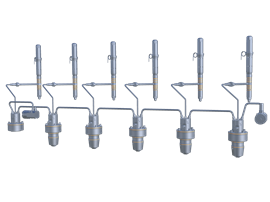 Marine four-stroke engines by MAN Energy Solutions will get new 2200-bar common rail injection.
Marine four-stroke engines by MAN Energy Solutions will get new 2200-bar common rail injection.
Stay tuned for the article to appear on our website.
MAN Energy Solutions introduced its second-generation, modular common rail injection system for its four-stroke engine portfolio. The CR 2.2 will eventually completely replace its CR 1.6 predecessor, which has been in use for more than 17 years on over 500 engines and 5,000 cylinders.
With its 2,200-bar injection pressure, the CR 2.2 will allow a very precise and flexible control of injection pressure, timing, and duration throughout engines’ entire operating ranges, to optimize engine performance, emissions and fuel consumption
The new common rail features an optimised and uniform high-pressure pump and a newly developed injector, integrating the CR 1.6 valve group. It has already successfully accumulated over 30,000 engine test hours on DMA and HFO fuels, and it is initially being introduced via the MAN 49/60DF engine.
OTHER PROPULSION AND FUEL HANDLING AND SUPPLY COMPONENTS:
Alfa Laval announced the Approval in Principle by classification society DNV of its Gas Combustion Unit (GCU) for hydrogen boil-off gas, a key technology for liquid hydrogen carrier vessels, where cargo venting is restricted and a GCU is needed to control tank pressure and temperature to safely combust hydrogen boil-off gas from the vessel’s storage tank.
Alfa Laval remarked how, unlike liquefied natural gas (LNG), hydrogen presents unique challenges for safe and efficient transportation at sea; it has a very low boiling point of -253° C, which leads to a higher boil-off rate during transport compared to LNG. Some of hydrogen’s properties – being light, highly flammable, and easily ignitable – also require a special attention to safety in the design of a GCU for hydrogen carriers.
The company also announced some interesting developments in the field of ammonia used as a marine fuel, among which the new Alfa Laval FCM Ammonia, with a fuel supply system (FSS) and an integrated fuel valve train (FVT) that isolates the engine from upstream systems and vent treatment system for ensuring a controlled vent release into the atmosphere.
Currently under development is also an ammonia dual-fuel boiler system that helps to safely handle boil-off ammonia evaporation and effectively remove ammonia vapor in the purge/vent stream, while generating steam to be used for the ship’s heat demand.
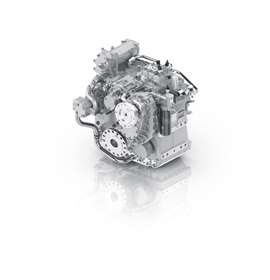 ZF introduced two new marine hybrid transmissions. Here type ZF-3200A/V PTI.
ZF introduced two new marine hybrid transmissions. Here type ZF-3200A/V PTI.
ZF introduced two new marine hybrid transmissions: the ZF 3200 A/V PTI for fast crafts and the ZF 3000 NRD PTI for Waterjet vessels.
The aluminum and compact design of the ZF 3200 A/V PTI hybrid transmission is indicated for fast craft with limited installation space in the power range from 1,295 kW to 1,940 kW.
It features a unique gearing design and an additional motor unit that can be connected via its own drive shaft – without reducing the permissible power of the main drive, making it possible to implement hybrid propulsion where it was previously challenging, such as in yachts, patrol boats and ferries.
The first project is set for delivery in the fourth quarter of 2024 and ZF reported interest from additional customers.
The ZF 3000 NRD PTI hybrid transmission is designed for waterjet vessels with a maximum output of 1,940 kW and 7,560 Nm torque on the main unit as well as 250 kW and 1,500 Nm on the electric power take-in (PTI).
It is based on the successful ZF 3000 transmission series and this variant can be coupled with electric motors thanks to its PTI.
ZF said customer projects with the new ZF 3000 NRD PTI have already been implemented; patrol boats and firefighting vessels outfitted with the new system are currently operating reliably in Asia.

